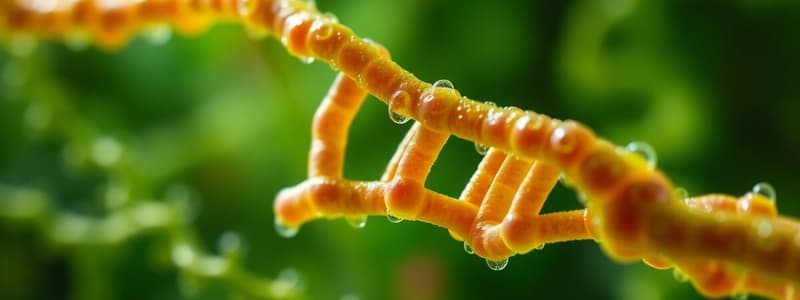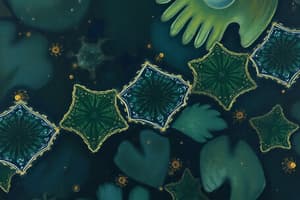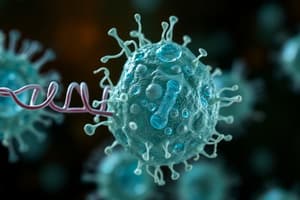Podcast
Questions and Answers
In prokaryotes, where do both transcription and translation occur?
In prokaryotes, where do both transcription and translation occur?
- In the mitochondria
- In the endoplasmic reticulum
- In the nucleus
- In the cytoplasm (correct)
Which of the following processes takes place in the nucleus of eukaryotic cells?
Which of the following processes takes place in the nucleus of eukaryotic cells?
- Translation
- Both B and C (correct)
- Transcription
- RNA processing
What is true regarding rRNA and tRNA synthesis?
What is true regarding rRNA and tRNA synthesis?
- They are transcribed and translated from genes
- They are transcribed but not translated (correct)
- They are not produced in cells
- They are proteins encoded by other proteins
What distinguishes eukaryotic cells from prokaryotic cells in terms of the central dogma?
What distinguishes eukaryotic cells from prokaryotic cells in terms of the central dogma?
Which statement about transcription and translation is correct?
Which statement about transcription and translation is correct?
Which type of RNA is primarily responsible for coding for proteins?
Which type of RNA is primarily responsible for coding for proteins?
What is the primary role of ribosomal RNA (rRNA) in the cell?
What is the primary role of ribosomal RNA (rRNA) in the cell?
Which statement is true about transfer RNA (tRNA)?
Which statement is true about transfer RNA (tRNA)?
Which of the following statements correctly describes the abundance of different types of RNA?
Which of the following statements correctly describes the abundance of different types of RNA?
What is the main difference between the roles of messenger RNA (mRNA) and transfer RNA (tRNA)?
What is the main difference between the roles of messenger RNA (mRNA) and transfer RNA (tRNA)?
What is the function of the template strand of DNA during transcription?
What is the function of the template strand of DNA during transcription?
Which statement correctly describes the non-template (coding) strand of DNA?
Which statement correctly describes the non-template (coding) strand of DNA?
What is true about the RNA transcript in relation to the template strand?
What is true about the RNA transcript in relation to the template strand?
How does the base sequence of the template strand relate to the other DNA strand?
How does the base sequence of the template strand relate to the other DNA strand?
Which statement is incorrect regarding the strands of DNA during transcription?
Which statement is incorrect regarding the strands of DNA during transcription?
What corresponds with the 5' end of a coding DNA strand?
What corresponds with the 5' end of a coding DNA strand?
Which statement accurately describes the polarity of RNA strands?
Which statement accurately describes the polarity of RNA strands?
What is the relationship between the 3' end of the coding DNA strand and the resulting mRNA?
What is the relationship between the 3' end of the coding DNA strand and the resulting mRNA?
What is the significance of the 3' sugar-OH end in nucleotide strands?
What is the significance of the 3' sugar-OH end in nucleotide strands?
Which of the following correctly matches the ends of coding DNA, mRNA, and proteins?
Which of the following correctly matches the ends of coding DNA, mRNA, and proteins?
What direction does RNA polymerase travel along the DNA strand during transcription?
What direction does RNA polymerase travel along the DNA strand during transcription?
Which of the following processes is NOT facilitated by RNA polymerase during transcription?
Which of the following processes is NOT facilitated by RNA polymerase during transcription?
What type of bond connects ribonucleotides during RNA synthesis?
What type of bond connects ribonucleotides during RNA synthesis?
What is one of the main advantages of RNA synthesis by RNA polymerase?
What is one of the main advantages of RNA synthesis by RNA polymerase?
Which enzyme is primarily responsible for forming the transcription bubble during transcription?
Which enzyme is primarily responsible for forming the transcription bubble during transcription?
What is the primary function of RNA polymerase I in eukaryotic cells?
What is the primary function of RNA polymerase I in eukaryotic cells?
Which component is crucial for the initiation of transcription in bacterial cells?
Which component is crucial for the initiation of transcription in bacterial cells?
What type of RNA is transcribed by RNA polymerase III?
What type of RNA is transcribed by RNA polymerase III?
What effect does Actinomycin D have on transcription?
What effect does Actinomycin D have on transcription?
Which RNA polymerase class in eukaryotes is responsible for mRNA transcription?
Which RNA polymerase class in eukaryotes is responsible for mRNA transcription?
Which of the following describes the RNAP core enzyme in bacteria?
Which of the following describes the RNAP core enzyme in bacteria?
What component is essential for the initiation of transcription?
What component is essential for the initiation of transcription?
In which direction does RNA elongation occur during transcription?
In which direction does RNA elongation occur during transcription?
What is the typical rate of RNA synthesis in bacteria?
What is the typical rate of RNA synthesis in bacteria?
What event signals the termination of transcription?
What event signals the termination of transcription?
What is the primary role of RNA polymerase during the elongation phase of transcription?
What is the primary role of RNA polymerase during the elongation phase of transcription?
What is the role of the σ subunit in bacterial RNA polymerase?
What is the role of the σ subunit in bacterial RNA polymerase?
Which of the following correctly identifies the location of the Pribnow box in relation to the transcription start site?
Which of the following correctly identifies the location of the Pribnow box in relation to the transcription start site?
How are sites designated upstream or downstream relative to the transcription start site?
How are sites designated upstream or downstream relative to the transcription start site?
What describes the term 'consensus sequences' in the context of E. coli promoters?
What describes the term 'consensus sequences' in the context of E. coli promoters?
What is the significance of the -35 consensus sequence in the context of transcription initiation?
What is the significance of the -35 consensus sequence in the context of transcription initiation?
Which element is specifically recognized by transcription factors to regulate gene transcription?
Which element is specifically recognized by transcription factors to regulate gene transcription?
What is the role of the TATA box in eukaryotic promoters?
What is the role of the TATA box in eukaryotic promoters?
In what context would the Downstream Promoter Element (DPE) be considered important?
In what context would the Downstream Promoter Element (DPE) be considered important?
Which of the following statements is true regarding eukaryotic promoters when compared to prokaryotic promoters?
Which of the following statements is true regarding eukaryotic promoters when compared to prokaryotic promoters?
Which sequence is known to surround the transcription start point in eukaryotic promoters?
Which sequence is known to surround the transcription start point in eukaryotic promoters?
Which transcription factor initiates transcription by binding to the TATA box?
Which transcription factor initiates transcription by binding to the TATA box?
What is the function of the BRE sequence recognized by TFIIB?
What is the function of the BRE sequence recognized by TFIIB?
Which regions can regulate eukaryotic gene transcription?
Which regions can regulate eukaryotic gene transcription?
Which transcription factor category is specific to RNA polymerase II?
Which transcription factor category is specific to RNA polymerase II?
Where is the TATA-binding protein (TBP) found within the transcription process?
Where is the TATA-binding protein (TBP) found within the transcription process?
What feature of intrinsic termination in transcription allows for the dissociation of the RNA transcript?
What feature of intrinsic termination in transcription allows for the dissociation of the RNA transcript?
Which factor is essential for rho (ρ) dependent termination in transcription?
Which factor is essential for rho (ρ) dependent termination in transcription?
What role does the hairpin structure play during the termination of transcription?
What role does the hairpin structure play during the termination of transcription?
What occurs immediately after the formation of the hairpin structure at the termination site?
What occurs immediately after the formation of the hairpin structure at the termination site?
Which of the following best describes how weak A-U base pairing affects transcription termination?
Which of the following best describes how weak A-U base pairing affects transcription termination?
Flashcards
Central Dogma
Central Dogma
The flow of genetic information from DNA to RNA to protein.
Prokaryotic Transcription/Translation
Prokaryotic Transcription/Translation
Both steps happen in the cytoplasm.
Eukaryotic Transcription
Eukaryotic Transcription
Takes place inside the nucleus.
Eukaryotic Translation
Eukaryotic Translation
Signup and view all the flashcards
Prokaryotic Cell
Prokaryotic Cell
Signup and view all the flashcards
mRNA
mRNA
Signup and view all the flashcards
tRNA
tRNA
Signup and view all the flashcards
rRNA
rRNA
Signup and view all the flashcards
Transcription
Transcription
Signup and view all the flashcards
Template Strand
Template Strand
Signup and view all the flashcards
Antisense Strand
Antisense Strand
Signup and view all the flashcards
Non-Template Strand
Non-Template Strand
Signup and view all the flashcards
Sense Strand
Sense Strand
Signup and view all the flashcards
Coding Strand
Coding Strand
Signup and view all the flashcards
DNA Polarity
DNA Polarity
Signup and view all the flashcards
RNA Polarity
RNA Polarity
Signup and view all the flashcards
Protein Polarity
Protein Polarity
Signup and view all the flashcards
DNA & RNA Correspondence
DNA & RNA Correspondence
Signup and view all the flashcards
Central Dogma of Molecular Biology
Central Dogma of Molecular Biology
Signup and view all the flashcards
RNA Polymerase
RNA Polymerase
Signup and view all the flashcards
Transcription Bubble
Transcription Bubble
Signup and view all the flashcards
DNA-RNA Base Pairing
DNA-RNA Base Pairing
Signup and view all the flashcards
RNA Polymerase Direction
RNA Polymerase Direction
Signup and view all the flashcards
Proofreading in Transcription
Proofreading in Transcription
Signup and view all the flashcards
Eukaryotic RNA Polymerases
Eukaryotic RNA Polymerases
Signup and view all the flashcards
RNA Pol I
RNA Pol I
Signup and view all the flashcards
RNA Pol II
RNA Pol II
Signup and view all the flashcards
RNA Pol III
RNA Pol III
Signup and view all the flashcards
Bacterial RNA Polymerase (RNAP)
Bacterial RNA Polymerase (RNAP)
Signup and view all the flashcards
Sigma Factor (σ)
Sigma Factor (σ)
Signup and view all the flashcards
Transcription Initiation
Transcription Initiation
Signup and view all the flashcards
Transcription Elongation
Transcription Elongation
Signup and view all the flashcards
Transcription Termination
Transcription Termination
Signup and view all the flashcards
Transcription Rate
Transcription Rate
Signup and view all the flashcards
Promoter
Promoter
Signup and view all the flashcards
σ Subunit
σ Subunit
Signup and view all the flashcards
-35 Sequence
-35 Sequence
Signup and view all the flashcards
-10 Sequence (Pribnow Box)
-10 Sequence (Pribnow Box)
Signup and view all the flashcards
Upstream/Downstream
Upstream/Downstream
Signup and view all the flashcards
Eukaryotic Promoters
Eukaryotic Promoters
Signup and view all the flashcards
Initiator (Inr)
Initiator (Inr)
Signup and view all the flashcards
TATA Box
TATA Box
Signup and view all the flashcards
BRE (TFIIB Recognition Element)
BRE (TFIIB Recognition Element)
Signup and view all the flashcards
Downstream Promoter Element (DPE)
Downstream Promoter Element (DPE)
Signup and view all the flashcards
Transcription Factor II
Transcription Factor II
Signup and view all the flashcards
TFIID
TFIID
Signup and view all the flashcards
TFIIB
TFIIB
Signup and view all the flashcards
Regulatory Regions
Regulatory Regions
Signup and view all the flashcards
What are upstream and downstream regions in Transcription?
What are upstream and downstream regions in Transcription?
Signup and view all the flashcards
Intrinsic Termination
Intrinsic Termination
Signup and view all the flashcards
Hairpin Structure
Hairpin Structure
Signup and view all the flashcards
Rho-dependent Termination
Rho-dependent Termination
Signup and view all the flashcards
Weak A-U Base Pairing
Weak A-U Base Pairing
Signup and view all the flashcards
What makes Rho-dependent termination different from intrinsic termination?
What makes Rho-dependent termination different from intrinsic termination?
Signup and view all the flashcards
Study Notes
Central Dogma of Gene Expression
- All cells, from bacteria to humans, follow the Central Dogma, which describes the flow of genetic information.
Prokaryotic Gene Expression
- Prokaryotes lack a nucleus.
- Both transcription and translation occur in the cytoplasm.
- rRNA and tRNA are transcribed but not translated from genes.
Eukaryotic Gene Expression
- Eukaryotes possess a nucleus.
- Transcription occurs within the nucleus.
- RNA processing happens within the nucleus.
- Translation occurs in the cytoplasm.
Studying That Suits You
Use AI to generate personalized quizzes and flashcards to suit your learning preferences.




